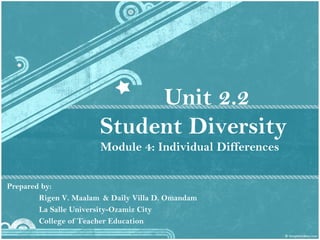
Student diversity
- 1. Unit 2.2 Student Diversity Module 4: Individual Differences Prepared by: Rigen V. Maalam & Daily Villa D. Omandam La Salle University-Ozamiz City College of Teacher Education
- 2. Advance Organizer Individual Differences (Student Diversity) Factors affecting Individual Differences Classroom Strategies for Student Diversity Benefits of Diversity in the Classroom
- 3. Factors that Bring about Student Diversity
- 4. How Student Diversity Enriches the Learning Environment 1. Students’ self-awareness is enhanced by diversity. 2. Student diversity contributes to cognitive development. 3. Student diversity prepares learners for their role as responsible members of society. 4. Student diversity can promote harmony.
- 5. Some Tips on Student Diversity 1. Encourage learners to share their personal history and experiences. 3. Aside from highlighting diversity, identify patterns of unity that transcend group differences. 2. Integrate learning experiences and activities which promote students’ multicultural and cross- cultural awareness.
- 6. Some Tips on Student Diversity 4. Communicate high expectations to students from all subgroups. 5. Use varied instructional methods to accommodate students diversity in learning styles. 6. Vary the examples you use to illustrate concepts in order to provide multiple contexts that are relevant to students from diverse backgrounds.
- 7. Some Tips on Student Diversity 8. Diversify your methods of assessing and evaluating student learning. 7. Adapt to the students’ diverse backgrounds and learning styles by allowing them personal choice and decision-making opportunities concerning what they will learn and how they will learn it. Purposely, form small- discussion groups of students from diverse backgrounds. You can form groups of students with different learning styles, different cultural backgrounds,
- 8. Some Tips on Student Diversity (summary) 1. Encourage learners to share. 2. Integrate learning experiences and activities. 3. Identify patterns of unity. 4. Communicate high expectations. 5. Use varied instructional methods. 6. Vary the examples you used.
- 9. Some Tips on Student Diversity (summary) 7. Adapt to the students’ background and learning styles. 8. Diversify your methods. 9. Form small-discussion groups.
- 10. Thank You!
